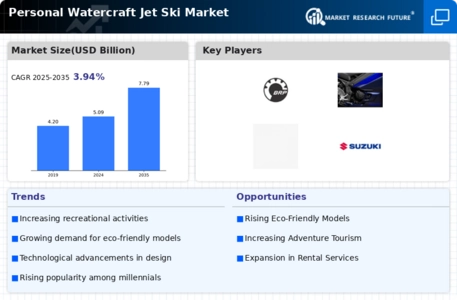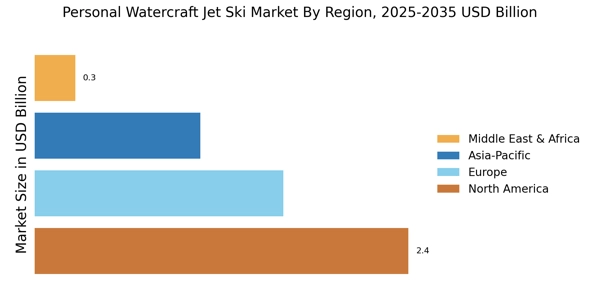Technological Innovations
Technological advancements play a crucial role in shaping the Personal Watercraft Jet Ski Market. Manufacturers are continuously integrating cutting-edge technologies into their products, enhancing performance, safety, and user experience. Innovations such as improved fuel efficiency, advanced navigation systems, and enhanced stability features are becoming standard in new models. For instance, the introduction of electric jet skis is gaining traction, appealing to environmentally conscious consumers. The market has witnessed a notable increase in sales of models equipped with smart technology, which allows users to monitor performance metrics in real-time. This trend indicates a shift towards more sophisticated personal watercraft, which could potentially attract a broader audience, including those who may have previously been hesitant to engage in water sports.
Increasing Recreational Activities
The rising interest in recreational activities is a notable driver for the Personal Watercraft Jet Ski Market. As more individuals seek outdoor experiences, the demand for personal watercraft has surged. In recent years, the number of registered jet skis has increased significantly, reflecting a growing trend towards water-based leisure activities. This shift is particularly evident among younger demographics, who are increasingly drawn to water sports and adventure tourism. The Personal Watercraft Jet Ski Market benefits from this trend, as consumers are willing to invest in high-quality, performance-oriented models that enhance their recreational experiences. Furthermore, the expansion of water sports events and competitions has contributed to the popularity of jet skis, encouraging enthusiasts to purchase their own units for personal use.
Growing Tourism and Rental Services
The expansion of tourism and rental services is a significant driver for the Personal Watercraft Jet Ski Market. As travel and leisure activities continue to flourish, many tourists seek thrilling experiences, including jet ski rentals. This trend has led to an increase in rental businesses, particularly in coastal and lakeside regions, where water sports are a major attraction. Data suggests that rental services account for a substantial portion of jet ski usage, with many operators reporting increased demand during peak seasons. This growth in the rental market not only boosts sales of personal watercraft but also encourages individuals to consider purchasing their own jet skis after experiencing the thrill of riding. Consequently, the Personal Watercraft Jet Ski Market is likely to benefit from this symbiotic relationship between tourism and personal ownership.
Enhanced Marketing and Brand Awareness
Enhanced marketing strategies and brand awareness initiatives are pivotal drivers for the Personal Watercraft Jet Ski Market. As competition intensifies, manufacturers are increasingly investing in marketing campaigns to differentiate their products and reach potential customers. Social media platforms and influencer partnerships have emerged as effective tools for promoting personal watercraft, allowing brands to engage with a wider audience. Furthermore, participation in trade shows and water sports exhibitions has become essential for showcasing new models and innovations. This heightened visibility not only attracts new customers but also fosters brand loyalty among existing users. As awareness of the benefits and enjoyment associated with jet skiing grows, the Personal Watercraft Jet Ski Market is likely to experience sustained growth, driven by informed consumers eager to explore the latest offerings.
Environmental Regulations and Sustainability
The increasing emphasis on environmental regulations and sustainability is influencing the Personal Watercraft Jet Ski Market. As governments implement stricter emissions standards, manufacturers are compelled to innovate and produce more eco-friendly models. This shift towards sustainability is not merely a regulatory response; it reflects a broader consumer preference for environmentally responsible products. The market has seen a rise in demand for jet skis that utilize cleaner technologies, such as electric propulsion systems, which align with global sustainability goals. This trend may lead to a transformation in the Personal Watercraft Jet Ski Market, as companies that prioritize eco-friendly practices could gain a competitive edge. Additionally, consumers are becoming more informed about the environmental impact of their purchases, further driving the demand for sustainable options.


















Leave a Comment